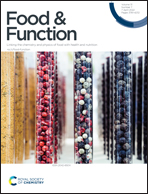Evaluation of the anti-osteoporotic effect of a low-phenylalanine whey protein hydrolysate in an ovariectomized mice model
Abstract
A phenylalanine (Phe)-restricted diet is indispensable to control the blood Phe for individuals with phenylketonuria (PKU), who are also confronted with progressive bone impairment. Thus, the development of a low-Phe protein substitute that could positively regulate bone metabolism is desired for their bone health. Our previous study reported the preparation of a low-Phe containing whey hydrolysate (LPH) from a selected whey protein hydrolysate (TAH). However, the effect of LPH on the bone status is unknown. In this study, we used an ovariectomized (OVX) mice model to evaluate the anti-osteoporotic potential of oral administration of whey protein concentrate (WPC, protein control), TAH, and LPH on bone physiology and bone metabolism. The results showed that after 12 weeks of treatment, the decreased bone mineral density, the deteriorated trabecular microarchitecture, and the reduced ultimate load due to ovariectomy were significantly attenuated by two whey protein hydrolysates (TAH and LPH); meanwhile, the body weight, uterine weight, bone composition, and the femoral elastic load of OVX mice had not been significantly affected by whey samples. In addition, LPH and TAH dual-regulated bone remodeling in OVX mice through triggering osteogenesis (promoted the expression of runt-related protein 2 (Runx2) and osteoformation markers) and inhibiting osteoresorption as well as inflammation. The modulated mitogen-activated protein kinase signaling and the inhibited nuclear factor κB signaling by LPH and TAH might relate to the dual-regulatory activities on bone. Overall, in the OVX mice model, LPH exerted higher osteoprotective potential than TAH of the same dose by activating the bone formation markers and inhibiting the inflammatory status. The current study demonstrated for the first time the potential use of a low-Phe whey hydrolysate, a protein substitute for PKU individuals, in the prevention of osteoporosis.



 Please wait while we load your content...
Please wait while we load your content...